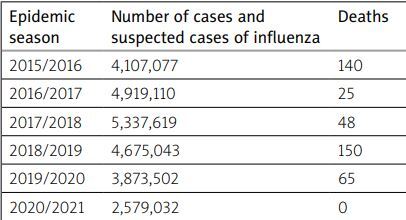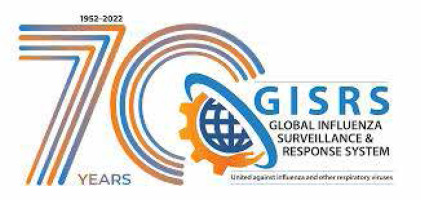Influenza has always been and will be in years to come a global and public health problem. Therefore the improvement and expansion of the Global Influenza Surveillance and Response System (GISRS) should be a priority for the healthcare community [1].
In 1947, at the 4th International Congress of Microbiologists in Copenhagen, the World Health Organization (WHO) foundations were laid for the future GISRS (which was finally created in 1952 and in 2022 celebrated its 70th anniversary) with the establishment of the first seven WHO Collaborating Centers for Reference and Research on Influenza in their current form. Since 1957 Poland has been participating in this system for monitoring influenza, as one of 149 National Influenza Centers worldwide. Poland was responsible for the introduction of the SENTINEL surveillance methods during its leadership of GISRS in the 2004/2005 epidemic season [2].
Virological data obtained by the Collaborating Centers for Reference and Research on Influenza are reported to the WHO and the European Union Agency: European Centre for Disease Prevention and Control (ECDC) [3].
As an example of such data, the information provided to the WHO by Poland concerning epidemic seasons from 2015/2016 to 2022/2023, including the time when the COVID-19 pandemic took place, is presented in Table I.
Table I
Confirmed infections with influenza and suspected influenza and flu-like virus infections in Poland in the seasons 2015/2016–2022/2023 (prepared by Brydak, 2022)
| Epidemic season | Number of cases and suspected cases of influenza | Deaths | Incidence per 100,000 | Mortality per 100,000 | Mortality [%] | Referred to the hospital |
|---|---|---|---|---|---|---|
| 2015/2016 | 4,107,077 | 140 | 10,685 | 0.048 | 0.003 | 15,969 |
| 2016/2017 | 4,919,110 | 25 | 12,799 | 0 | 0 | 16,890 |
| 2017/2018 | 5,337,619 | 48 | 13,888 | 0 | 0 | 18,320 |
| 2018/2019 | 4,675,043 | 150 | 12,170 | 0.05 | 0.004 | 17,499 |
| 2019/2020 | 3,873,502 | 65 | 10,083 | 0.169 | 0.001 | 17,613 |
| 2020/2021 | 2,579,032 | 0 | 6,577 | 0 | 0 | 5,745 |
| 2021/2022 | 3,867,851 | 6 | 9,805 | 0 | 0 | 12,413 |
| 2022/2023* | 946,819 | 0 | 420 | 0 | 0 | 3,355 |
* Data presented in Table I in the epidemic season applies to the period from October 1, 2023 to the date of the conference at the Institute of Rheumatology and Geriatrics, i.e. until November 10, 2023.
On March 11, 2020, the WHO announced the COVID-19 pandemic. As shown in Table I, the values of all the indicators used for influenza monitoring were definitely lower at the time of the pandemic. This phenomenon is attributed to the fact that a significant part of the population worked remotely, including schools and universities, and mandates to wear masks were introduced to avoid the transmission of respiratory infections. The number of deaths resulting from post-influenza complications reported in Poland is underestimated – which is true not only in the case of data presented in Table I, as some deaths are attributed to the wrong disease entity.
In the 2021/2022 epidemic season, i.e. from October 1, 2021 to September 30, 2022, a total of 2,317 samples collected from patients in seven age groups were tested in Poland using the molecular biology method. Positive results were confirmed in 408 people (18.24%). The highest percentage of confirmed cases of influenza infection was registered in the group of children: aged 5–9 years – 32.63%; aged 0–4 years – 29.58%; aged 10–14 years – 11.50%. In the remaining age groups, the following data were obtained: aged 15–25 years – 5.40%; aged 26–44 years – 5.16%; aged ≥ 65 years – 5.10%; aged 45–64 years – 3.05%.
In the 2021/2022 epidemic seasons, 3,752,037 suspected and confirmed cases of influenza, 12,413 hospitalizations and 6 deaths were registered. In the obtained data the influenza A virus dominated.
The global virological monitoring of influenza is of great importance, taking into account not only its clinical aspect but also the process of proper selection of strains for new influenza vaccines – an important part of the prophylaxis of influenza. In the epidemic season 2022/2023, according to WHO recommendations, the influenza vaccine contains two subtypes of influenza A virus – A/Victoria/250/2019(H1N1) podm09 (like virus), A/Darwin/2021(H3N2) (like virus) – and two lines of influenza B virus: B/Austria/1359417/2021 (like virus) line Victoria and B/Phuket/3073/2013 (like virus) line Yamagata. The Centre for Disease Prevention and Control recommended in season 2022/2023 three vaccines for people of age 65 years or older: Fluzone High-Dose Quadrivalent vaccine, Flublok Quadrivalent recombinant flu vaccine and Fluad Quadrivalent adjuvanted flu vaccine [3, 4].
In Poland, during the 2022/2023 epidemic season, two types of inactivated influenza vaccines administered intramuscularly are available: split and subunit. Additionally, a “live” vaccine administered intranasally is also accessible, obtained from cold-adapted influenza viruses, i.e. exposed to a reduced replication temperature.
Worldwide, there is a consensus that vaccinations, when available, are the best way to fight infectious diseases. However, despite many years of educational activities, publicizing the fact that vaccinations are the cheapest method of preventing post-influenza complications, only part of the population understands the purpose of this highly effective method of battling influenza [5–11].
Efficient prophylaxis is of particular importance for patients with chronic diseases, including rheumatic/autoimmune ones, and the European Alliance of Associations for Rheumatology (EULAR) has presented clear recommendations on the advisability of vaccinations in this group of patients [12].
The influenza virus infection should be considered not only in terms of exacerbating an existing disease or causing a new one, but also in terms of the measurable, quantifiable financial effects it has on the healthcare system, covered by public funds. The research conducted by Polish scientists (in the 2019/2020 epidemic season) confirmed the role of anti-influenza-anti-haemagglutinin antibodies in the milder course of COVID-19 infections [13].
There are also no contraindications (CDC) for simultaneous vaccination of COVID-19 and influenza [14]. Slightly more post-vaccination reactions, such as chronic fatigue, were observed when the influenza vaccine was administered simultaneously with a booster dose of COVID-19 vaccination [15].
Conclusions
The participation of the National Influenza Centers in GISRS is important for collecting data that will allow development of strategies aimed at reducing the number of influenza cases and alleviating its course.
A seasonal influenza vaccination is the cheapest and most effective method of preventing post-influenza complications.
Influenza vaccination may reduce the course of infection caused by COVID-19.
Influenza prevention is also an important preventive measure against the development and exacerbation of chronic diseases, including rheumatic diseases.




